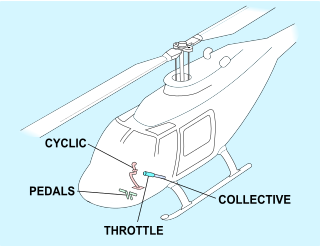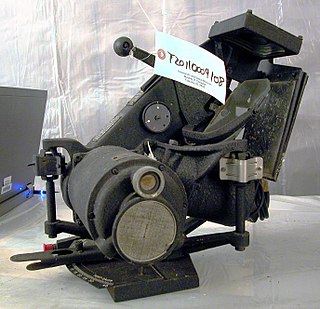
An airfield traffic pattern is a standard path followed by aircraft when taking off or landing while maintaining visual contact with the airfield.
Dynamic soaring is a flying technique used to gain energy by repeatedly crossing the boundary between air masses of different velocity. Such zones of wind gradient are generally found close to obstacles and close to the surface, so the technique is mainly of use to birds and operators of radio-controlled gliders, but glider pilots are sometimes able to soar dynamically in meteorological wind shears at higher altitudes.

The Norden Mk. XV, known as the Norden M series in U.S. Army service, is a bombsight that was used by the United States Army Air Forces (USAAF) and the United States Navy during World War II, and the United States Air Force in the Korean and the Vietnam Wars. It was an early tachometric design, which combined optics, a mechanical computer, and an autopilot for the first time to not merely identify a target but fly the airplane to it. The bombsight directly measured the aircraft's ground speed and direction, which older types could only estimate with lengthy manual procedures. The Norden further improved on older designs by using an analog computer that continuously recalculated the bomb's impact point based on changing flight conditions, and an autopilot that reacted quickly and accurately to changes in the wind or other effects.

A total station or total station theodolite is an electronic/optical instrument used for surveying and building construction. It is an electronic transit theodolite integrated with electronic distance measurement (EDM) to measure both vertical and horizontal angles and the slope distance from the instrument to a particular point, and an on-board computer to collect data and perform triangulation calculations.

A fire-control system (FCS) is a number of components working together, usually a gun data computer, a director and radar, which is designed to assist a ranged weapon system to target, track, and hit a target. It performs the same task as a human gunner firing a weapon, but attempts to do so faster and more accurately.

Helicopter flight controls are used to achieve and maintain controlled aerodynamic helicopter flight. Changes to the aircraft flight control system transmit mechanically to the rotor, producing aerodynamic effects on the rotor blades that make the helicopter move in a desired way. To tilt forward and back (pitch) or sideways (roll) requires that the controls alter the angle of attack of the main rotor blades cyclically during rotation, creating differing amounts of lift at different points in the cycle. To increase or decrease overall lift requires that the controls alter the angle of attack for all blades collectively by equal amounts at the same time, resulting in ascent, descent, acceleration and deceleration.

A bombsight is a device used by military aircraft to drop bombs accurately. Bombsights, a feature of combat aircraft since World War I, were first found on purpose-designed bomber aircraft and then moved to fighter-bombers and modern tactical aircraft as those aircraft took up the brunt of the bombing role.

In aviation, a crosswind landing is a landing maneuver in which a significant component of the prevailing wind is perpendicular to the runway center line.

The Stabilised Automatic Bomb Sight (SABS) was a Royal Air Force bombsight used in small numbers during World War II. The system worked along similar tachometric principles as the more famous Norden bombsight, but was somewhat simpler, lacking the Norden's autopilot feature.

The Mark XIV Bomb Sight was a bombsight developed by Royal Air Force (RAF) Bomber Command during the Second World War. It was also known as the Blackett sight after its primary inventor, P. M. S. Blackett. Production of a slightly modified version was also undertaken in the United States as the Sperry T-1, which was interchangeable with the UK-built version. It was the RAF's standard bombsight for the second half of the war.
The Carl Zeiss Lotfernrohr 7, or Lotfe 7, was the primary series of bombsights used in most Luftwaffe level bombers, similar to the United States' Norden bombsight, but much simpler to operate and maintain. Several models were produced and eventually completely replaced the simpler Lotfernrohr 3 and BZG 2 bombsights. The Lotfe 7C, appearing in January 1941, was the first one to have gyroscopic stabilization.

The Blackburn B.T.1 Beagle was a British single-engine, two-seat biplane bomber/torpedo aircraft from 1928. Designed to Air Ministry specifications which led to no contracts for any manufacturer, only one Beagle was built.
Harry Egerton WimperisWh.Sch was a British aeronautical engineer who acted as the Director of Scientific Research at the UK's Air Ministry prior to World War II. He is best known for his role in setting up the Committee for the Scientific Survey of Air Defence under Henry Tizard, which led directly to the development and introduction of radar in the UK. He is also known for the development of the Drift Sight and Course Setting Bomb Sight during World War I, devices that revolutionised the art of bombing.

The Course Setting Bomb Sight (CSBS) is the canonical vector bombsight, the first practical system for properly accounting for the effects of wind when dropping bombs. It is also widely referred to as the Wimperis sight after its inventor, Harry Wimperis.
Green Satin, also known as ARI 5851, was a Doppler radar system developed by the Royal Air Force as an air navigation aid. The system provided direct measures of the drift speed and direction, and thereby allowed accurate calculation of the winds aloft. These values were then fed into the Navigation and Bombing System.

The Low Level Bombsight, Mark III, sometimes known as the Angular Velocity Sight, was a Royal Air Force (RAF) bombsight designed for attacks by aircraft flying below 1,000 feet (300 m) altitude. It combined components of the Mark XIV bomb sight with a new mechanical computer. It featured a unique solution for timing the drop, projecting a moving display onto a reflector sight that matched the apparent motion of the target at the right instant.
A power-off accuracy approach, also known as a glide approach, is an aviation exercise used to simulate a landing with an engine failure. The purpose of this training technique is to better develop one's ability to estimate distance and glide ratios. The variation in each angle refers to the degrees an aircraft must turn to be aligned with the runway. Consideration of the wind and use of flaps are important factors in executing power-off accuracy approaches.
The Bombenzielanlage, sometimes referred to as the Bomb Ziel Automat (BZA), was a German World War II bombsight analog computer designed to calculate the precise release of bombs during dive-bombing. It was fitted to a number of aircraft types, including the Junkers Ju 88 and the Arado Ar 234. The unit controlled an aiming mark on sight in front of the pilot. The computer assessed the angle of dive, aircraft track, and altitude. The operator set other variables, such as barometric pressure, target altitude, airspeed and wind speed. During operation, the bomb(s) were released when an aiming mark coincided with the target.
The Bombsight, Pilot-Directing, Mark III was an inter-war era bombsight developed by the US Navy to equip its bomber aircraft. It was a development of the British Course Setting Bomb Sight, or CSBS, which had been introduced in UK service in early 1918 and was demonstrated to the Navy in Washington in May 1918. As the primary bombers in Navy service at the time were flying boats where the pilot and bombardier were separated, Mark III modified the CSBS to include an electrically driven pilot direction indicator.

The Estoppey D-series was a line of inter-war era bombsights developed by Georges Estoppey of the US Army Air Corps' McCook Field starting with the D-1 of 1922. A key feature was the use of a pendulum to keep the bombsight correctly oriented towards the ground even as the aircraft maneuvered, and dashpots to keep it from swinging around in turbulence. In testing in 1923, it proved more accurate than the US Navy's Mark III or the Army's Mk. I, and twice as accurate as the older Michelin bombsight designs. A series of minor updates led to the first widely used production model, 1925's D-4, of which several hundred were produced. The design was among the most advanced of its era but was still inaccurate to the point of being useless over 8,000 feet (2,400 m) altitude.














